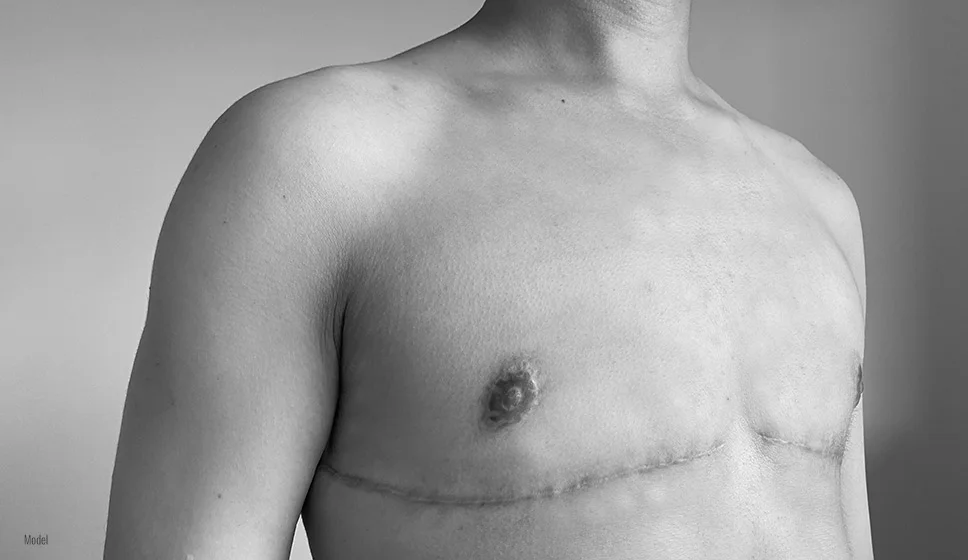Home|Blog | What Kind of Scars Should I Expect From FTM/FTN Top Surgery?
What Kind of Scars Should I Expect From FTM/FTN Top Surgery?

As much as patients are excited to embark on a transformative journey, they always feel more empowered and comforted when they understand what to expect. Female-to-male (FTM) and female-to-gender nonbinary (FTN) top surgery are gender-affirming procedures designed to remove breast tissue and create either a more masculine chest contour, a gender-neutral or other chest appearance.
This surgery is an essential step for many transgender men and non-binary individuals in their transition journey. While the primary focus is often on achieving the desired chest shape and alleviating gender dysphoria, understanding the types of scars that can result from the surgery is crucial for setting realistic expectations.
This blog will review different incision techniques for FTM and FTN top surgery, factors influencing scar formation and ways to minimize scars post-surgery.

Types of FTM and FTN Top Surgeries and Their Resulting Scars
The appropriate FTM and FTN top surgery technique depends on chest size, skin elasticity, chest configuration, weight and patient preferences. Below are the most common FTM and FTN top surgeries and the type of scars you can expect to receive from each.
Double Incision Mastectomy
The double-incision (DI) mastectomy is the most common FTM and FTN top surgery method that is best for individuals with larger chests or those with less skin elasticity. This approach can also be selected in individuals with small breasts. It involves two horizontal or oblique incisions across the chest along with removal of breast tissue and contouring. The nipples can either be placed back as grafts (FNG or free nipple grafts) in the desired location or not be put back on at all.
This double incision technique typically results in scars of varying lengths on each side of the chest. On occasion, they may even need to be joined in the middle, overlying the sternum.
In the early postoperative period, these scars can be prominent but they do fade significantly over time. Especially with proper care, they can become relatively inconspicuous. If the nipple-areola complexes are placed back on as grafts, there will also be scars around them.
Keyhole Mastectomy
The keyhole mastectomy technique is ideal for individuals with small chests and little to no skin excess. This is generally relevant for an “A” or “B” cup breast. It involves a small incision around the bottom half of the areola through which the breast tissue is removed.
With its short incision, the keyhole technique results in a very limited scar and one that usually heals extremely well. However, this comes with a greater risk of postoperative bleeding and permanent contour issues. This approach is absolutely contraindicated in individuals with larger breasts.
Concentric Circle or Periareolar Mastectomy
This top surgery technique is suitable for those individuals with smaller chests and relatively good skin elasticity. The approach involves a circular incision made around the areola, which also allows for reducing its size and/or removing excess surrounding skin. Of course, this also provides access to the breast tissue that is to be removed.
This technique results in scars around the perimeter of the areola. These circular scars are generally less noticeable than those eventuating from the double incision method. Since the incisions are made around the natural border of the areola, they often blend well with the surrounding skin. Individual characteristics can impact this, though.
Inverted “T” Mastectomy
This method is used for individuals with moderate to large breasts and poor skin elasticity who still want some breast tissue to remain, though typically a small amount. Using the same incisions as in a breast reduction, the indications for this approach are very limited. For example, it is occasionally requested by gender-fluid individuals who want very small breasts so as to be able to express a feminine gender when they desire.
The incisions are more extensive than those with other techniques and is identical to those used in a breast reduction. They extend from around the areola, vertically down to the chest crease, and along the inframammary fold.
Nipple Grafts, No Nipples or Nipple Tattoos
Top surgery is entirely customizable. “You can have it your way.”
Almost.
The overwhelming majority of FTM individuals want to have nipple-areola complexes. This percentage is somewhat lower in gender nonbinary individuals seeking FTN top surgery. Then there are some individuals who electively have 3D nipple-areola tattoos done at a later time.

Be sure to read our blog about how to care for your FTM and FTN top surgery scars.
Phoenix, Arizona FTM and FTN Top Surgery Specialist
Dr. Steven Turkeltaub is a highly respected plastic surgeon, board certified by the American Board of Plastic Surgery, who specializes in gender-affirming top surgery and cosmetic breast surgery in Phoenix and Scottsdale, AZ. His skill and experience can help you achieve your aesthetic goals while minimizing scars and the risk of complications.
Call our office at (480) 451-3000 or email us today to schedule your consultation!
